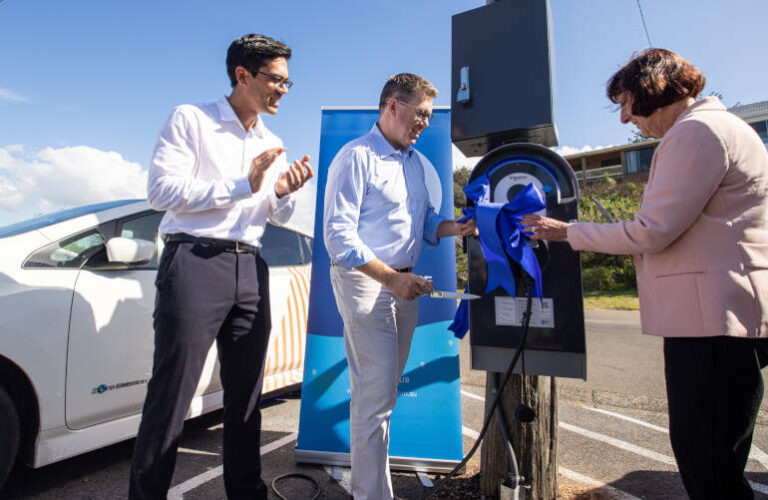Seven new pole mounted electric vehicles chargers have been installed across the Lake Macquarie LGA to help fuel the rapid take-up of electric vehicles across the region.
They are part of the EV Streetside Charging Project led by consumer energy and smart metering specialists Intellihub and supported by the Australian Renewable Energy Agency and Lake Macquarie City Council.
The 22 kilowatt chargers have been installed on electricity power poles in Cardiff, Redhead, Dudley, Charlestown, and Morisset.
Each EV charging station is connected directly to the overhead electricity supply, with energy use matched with 100 per cent accredited GreenPower.
The Member for Shortland the Hon Pat Conroy and Lake Macquarie Mayor Kay Fraser today officially powered up one of the new pole-mounted chargers at a beachside parking spot in Redhead.
Local EV motorist Leah Stevens was also invited to park alongside the charger and get a quick top up charge from the Mayor and Minister Conroy.
Intellihub CEO Wes Ballantine said the streetside chargers were a convenient public charging option for local motorists.
“Power poles line most streets and that represents an enormous opportunity for local communities needing a range of public charging solutions,” Mr Ballantine said.
“Motorists can use the chargers while shopping, seeing friends or at the beach. It’s as simple as driving up, plugging in, and using the Exploren app to start charging.
“They’re an accessible, safe, and practical option for EV charging, particularly for motorists without access to off-street parking.”
A two hour session on each charger will typically provide enough power for around 200km of driving. A full charge will cost around $35, depending on the car’s battery capacity.
The public charging will be managed via the Exploren platform, developed by leading Australian EV software and hardware providers EVSE.
Lake Macquarie EV Streetside charger locations
- Harrison St Cardiff Beach Rd
- Redhead Bridge St Morisset
- Station St Morisset (2 chargers)
- Smith St Charlestown
- Ocean St Dudley
Cr Fraser said the number of electric vehicles registered across the Lake Macquarie LGA had increased by more than 140 per cent over the past 12 months.
“There are more than 800 electric vehicles registered across our council area, and that number continues to grow each month,” Cr Fraser said.
“Accessible public charging infrastructure is central to supporting our residents already driving electric vehicles and for those people contemplating buying one for their next car purchase,” she said.
“The new chargers are displayed on all public EV charging maps. So, every EV driver will know they can charge their EV in Lake Mac while they explore our region.”
The Member for Shortland Pat Conroy said it was important that EV drivers in regional areas like Lake Macquarie did not miss out on public charging infrastructure.
“The project is supported by the Australian Government and will ensure that EV drivers around Lake Macquarie and the Lower Hunter can access public charging infrastructure,” Mr Conroy said.
“A diverse mix of public and private EV charging solutions are an important way to support the growing numbers of motorists choosing electric vehicles here and outside our region.”
Local EV motorist Leah Stevens said the EV chargers would be a great asset for the local community.
“I do a lot of my charging at home, but I also need different types of public chargers when I’m not at home and might be running low,” Ms Stevens said.
“Putting chargers in popular public areas makes it easy to get a quick charge when you’re running around, at the beach or shops. It sends a great message to the local community and visitors to the area.”
Around nine per cent of all new car sales across Australia last year were electric vehicles, according to the Electric Vehicle Council. It estimates that there now more than 180,000 EVs on Australian roads.
The Australian Energy Market Commission estimates that there will be 22 million EVs in Australia by 2050. Fifty chargers are being installed across Sydney under the pilot project. Its aim is to test the commercial, regulatory and customer demand for pole mounted EV chargers.






